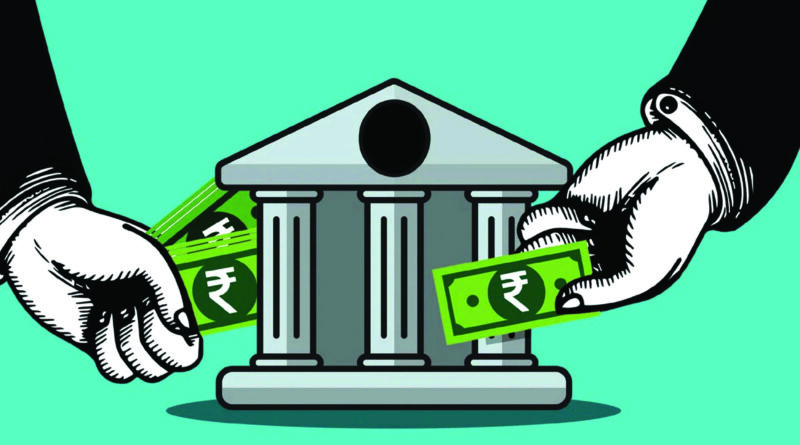Digital Banking: The Need of the Hour
Development of an economy, especially economic growth primarily depends on industrial development. The industries depend on financial institutions support for funds especially from banks. Banks encourage individuals save and mobilise funds from bank deposits. Banks play a pivotal role in motivating earners save and deposit; pay interest on deposits; lend money to the needy individuals, institutions, and business organisations; give guarantees on behalf of the applicant to cover payment obligation to a third party; facilitate trade and commerce; offers payment facilities to various local and international business houses; offers secure services to help individuals. Therefore, banks are playing a pivotal role in building nation for more than a century, and we cannot imagine an economy without banks.
Origin of Bank
The need for bank rose when people earned money and wealthy people wanted to keep money safe. The general meaning of banking is an intermediation activity. Trace of banking activity may be long ago as an ancient Mesopotamia at royal palaces, religious temples and citizens houses where valuable merchandise kept and the ownership title assigned by receipt of deposit. Temples were understood safe place and believed that they were watched by God. Loans were given by temples of Babylon in the beginning of 2000 BCE.
The oldest banks across the word are: Banca Monte Dei Paschi di Siena was founded in 1472, Tuscan city of Siena, followed by Berenberg bank in 1590, Sveriges Riksbank in 1668, C. Hoare & Co. in 1692 and Bankhaus Meltzer in 1671.
Literature shows that banking in India originated in 1700s and Bank of Bombay was the first bank set up in 1720. But, Bank of Hindustan is known as of India’s first modern banks founded in Calcutta in 1770. Certain banks set up in the mid-1800s were merged and called themselves as Imperial Bank of India. Later it is called as State Bank of India. In Indian banking industry nationalisation of 14 commercial banks is an important change and in 1980 six banks. The first ATM came in Mumbai in 1987 and today, the ATMs capable of delivering many other services like checking account balance; transfer of money, bill payments, cash deposits, etc. Banking sector in India travelled a long way and with the use of computers and information technology banks moved from traditional systems to digital systems.
Over the recent past, India seen a remarkable digital shift in banking industry. This shift was results of the Indian government’s initiatives motivating use of digital banking platforms for banking. Simple, accessible and transparent banking is result of digital banking.
The Evolution of Digital Banking
One cannot imagine economic growth without technological development. As said earlier economy depends on industries growth, industries growth depends on banks. Technology is the reason for seeing unimaginable move from traditional to digital banking across the world during the last two decades. Introduction of Automated Teller Machines (ATMs) was the beginning of digital banking and flourished due to access to internet and affordable smart phones. This transformed customer’s expectations and banks came up with innovative processes and products. With the use of technology banks offered 24×7 services by the end of 20th Century. Today, customers carry their banking facility with them, on their smartphones without involving the banking staff. Government of India’s vision ‘cashless economy’ has been accelerated by facilitating internet access throughout the nation with online banking being the need of the hour due to Covid 19.
Digital Banking – Concept
Digital banking is the use of electronic gadgets computers, phones and electronic platforms to conduct various banking transactions without bank employees’ interaction. Checking account balance; transferring funds; paying bills; applying for loans; applying for – cheque books, ATM-cum-Debit Cards, credit cards, opening accounts, change of card pins and many more.
Digital Banking – An Edge over Traditional Banking
Digital banking has edge over traditional banking in terms of : Convenience of banking transaction from the customer comforts of area; 24*7 access to banking functions; Facilitates online payments; empowers customer schedule of payments; Saves time, effort and cost of bank transaction; Accessible bank services from remote areas; Helps monitor amount in accounts; Reduce of fake currency with electronic funds transfer; Restricts circulated of unaccounted/black money; Helps block misplaced ATM/Debit and credit cards through call or online banking; Paperless banking and the like.
Digital Banking Modes
Digital banking can be done using computers, mobile phones, electronic platforms, banking cards – ATM/Debit card, Credit card and use of various UPI payment apps –PhonePe, BHIM, Amazon Pay, Paytm, Google Pay, Cred, BharatPe and the like. Further, banks have their own digital banking apps.
The Need of the Hour
The following paras make clear the need for digital banking:
1. Moving from Books to Computers: Olden-days banks were used books to enter transactions. These books provide inputs to management to understand and analyse business details like deposits, loans, assets, liabilities, income, expenditure, balance-sheet items. Maintenance of records is very much necessary for meeting the requirements of different account holders. For example, payment of interest on different types of deposits needs to be done on time as and when the maturity or period arises. There were various other needs as per regulations for maintaining records. The primary aim of records to enter details on day-to-day basis as and when accountholders transacts with bank, store and retrieve when required. Banks deals day-in and day-out, high risky documents need to be preserved carefully for future reference. Therefore, proper handling and retention of records assumes great significance. This was easy when the numbers of accountholders are less and transaction frequency is less. But, it was difficult to maintain books and deliver services on time. So, computerisation of banking was necessary then.
2. Computerisation: The necessity of computerisation of banks was sensed in late 1980s. As per the report released in 1985 by Reserve Bank of India (RBI) banks were facing different types of difficulties like increasing delays in the posting and balancing of various ledgers leading to give a way for fraud; statement of accounts are not properly and legibly compiled; out of date passbooks; unnoticed standing instructions; enormous delays in clearing of cheques; huge delays in the payment of cash cheques at banks where teller system in not in place; revenue leakage through short-collection of interest, and so on.
Further, banks were not able to fine-tune policy measures due to difficulty in processing of large volumes of out dated data, unprocessed data, and lack of vital current data. All these led to streamline bank operations to avoid deep troubles. So, computerisation was needed in late 10980s.
Banks introduced standalone Personal Computers and later migrated to Local Area Network (LAN) connectivity. Computerisation of banks gained pace with the liberalisation of economy in 1991, which led to the rising competition from private and foreign banks. For remain competitive in the market, several commercial banks initiated the steps towards providing customer services digitally through core banking.
3. Core Banking: Traditional core banking system faced several issues. The major issues are: processing transactions in real time, leveraging partnerships with fintech companies, poor digital customer experience without flexibility, complexities during platform integration after M&As, scaling infrastructure needs as required, launching new features frequently, risk and compliance management, high maintenance cost, and high reliance on vendor. To address these issues, a core banking introduced in 1980 with error free banking business with cloud-ready and open-bankingcompliant and have very advanced architectures made frequent feature releases smooth. With the adoption of core banking platform, branch banking changed to bank banking. Core Banking Solution (CBS) helped various core banking platforms, among them the popular platforms are: Finacle (by Infosys), BaNCS (by TCS), and FLEXCUBE (by i-flex) gained popularity. These platforms are the reason for offering greater customer experience at reasonable price. No more consumers accept generalised services, and they are demanding for customised efficient services. So, banks need focus on meeting the customer demands and live upto their expectations. Government of India was focussed on inclusive growth, especially financial inclusion.
4. Financial Inclusion: Financial inclusion is increasingly gained significance in promoting equity and economic growth across the globe. The same was included prominently in Indian public policy agenda for a quite long-time. Financial inclusion was very much required for inclusive growth and development. In India was very less number of adults possessed account in bank by 2011 which was well below the average of other emerging market economies (Kunt et.al., 2018). 12 per cent adults saved money, eight per cent adults borrowed from financial institution. People were using cash widely with the currency in circulation was about 12 per cent of gross domestic product (GDP). There were 21 ATMs per 100,000 adults, IMF Financial Access Survey. Since then, various governments initiated digital foundation as base for increase in financial inclusion. Launch of Aadhaar, and the biometric digital ID system in 2010 was a game changer which allowed open bank accounts by reducing time and cost of the “Know Your Customer” (KYC) process. Only 30 per cent of Indian population had a bank account by 2014. The key structural change in access to financial services arose with the launch of the ‘Pradhan Mantri Jan Dhan Yojana (PMJDY)’ scheme in August A range of features of PMJDY include a no-frills, zero-balance account with a debit card, access to mobile banking for funds transfer, overdraft facilities, and bank account provides life insurance coverage for account holders. Bank accounts under PMJDY could be opened using the Aadhaar ID and subsequently linked to it for the transfer of government benefits. By 2017 around 90 per cent of the population possessed an Aadhaar and half of them linked their Aadhaar number to their bank accounts. It is further supported by rapid changes in technology and digitalisation gave an opportunity to expand financial inclusion. Financial inclusion cannot be more effective until small businesses, youth, women and people from rural are part of the formal banking system. Therefore, aim of increasing financial inclusion was depended on digital banking. Opening bank account thorugh the PMJDY scheme might be the pre-plan of government to motivate people go for digital payments after Demonitisation.
5. Demonetisation: On 8th November, 2016, the Government of India all of a sudden announced the demonetization of major banknotes, withdrawn 86 per cent of currency from circulation and constraining the use of cash. (Lahiri, Amartya. 2020). The aim of demonetisation was to seize undeclared income, increase tax base, destroy counterfeit currency, and remove corruption and to speed up formalisation of the economy. Whatever may be the motive, but demonetisation forced people use electronic payments. There was no option except use of electronic banking services during the period of demonetisation. People slowly started banking transactions in digital mode due to owning smartphone is affordable and affordable internet data.
6. Owning Smart Phone: Across the world there is real transformation in providing financial services digitally. The change is possible and supported by affordable smartphone and growing use smartphones and affordable internet data. Developing world’s first smartphone ‘Simon’ goes to IBM, sold by BellSouth (formerly part of the AT&T Corporation) in In India the first affordable touchscreen smartphone ‘Nokia 5800 XpressMusic’ was launched back in 2008. There were 34.18 million smartphones users in 2010, and reached to 938.27 million in 2022. The number of smartphone users in India was estimated to reach over one billion and 1.55 billion by 2023 and 2024 respectively, as per recent data by market research firm Statista. Apart from internet, Smartphones are playing an important role in India’s digital transformation. Smartphone and access to internet data made the need to motivate for digital banking services among customers.
7. Affordable Internet Data: Transformation of banking landscape began in the 2010s with the internet accessibility. As learned above access to internet data is prime factors for the current growth of the digital banking transactions. After launch of 5G, the speeds of internet has seen a 3.59 times increase, with median download speed increasing from 13.87 Mbps in Sept. 2022 to 50.21 Mpbs in August 2023 (Shinde, 2nd 2023). India rank 47th on the basis of mean broadband speeds and is steadily raising from 101th in 2020 to 47th in 2023 reads a study by Ookla (Kechiche, S. (2023). As on December, 2022, around 88 per cent of households with smartphones, as well as internet connectivity, are around 88 per cent. Therefore, increase in internet speed another factor supported the growth of the digital payments ecosystem. Reduced processing time, ease of use, network connectivity, cyber security and compatibility are the key factors which motivate users to adopt digital banking. People have smartphones and access internet data this helped go for digital banking and automatically encouraged people buy products and services online.
8. Online Shopping: Online shopping is another driver of the growth of digital payments ecosystem in India. COVID-19 pandemic forced go for online shopping and it became the new normal. The number of annual online shoppers was 105 million in 2019 and reached to 185 million by 2021 indicating the force of COVID 19 in going with online shopping. Indian e–commerce market is expected to reach $200 billion by 2026 from US38.5 billion as of 2017 (Economic Diplomacy Mission, 2020). All those who were hesitating to go for online shopping in the name of privacy and security, were bought online during COVID 19 pandemic. For buying or selling online one has to use digital payment or receipts. So, there is a need for digital banking.
9. Saves Time and Money: People are buying online due to lack of time, convenience of buying online and digital banking. Due to lack of time to visit bank for financial services like de positing, drawing money; placing request for chequebook, passbook entry, taking a statement of account, buying Demand Draft etc. Using digital banking services a customer can get the work done without visiting bank and save precious time.
Across the world, banks can charge customer for any service for which they incur and it is practiced by Indian banks too. If no cost is incurred for providing a service, then banks refrain from the charging customer. In fact, the RBI does not restrict banks from charging a fee for transactions, but restricts unreasonable charges. No banking service is free. Every banking service involves cost and the cost may be borne by the bank or the customer. According to experts from banking industry, normally a bank spends on an average Rs.40 per transaction done at bank. For example, if a customer deposits a physical cheque from another bank for collection, it involves cost for the both banks, and this can be avoided or reduced in the transaction is done by digital banking. In future, banks need to be recovering banking transaction costs from customers to sustain themselves.
10. Reach Remote Areas: Two decade back India was a country of disparities with both the busy metropolises where we can find everything and rural areas with no or very limited access to modern technology. With the launch of National Optical Fibre Network (NOFN) in October 2011, rural areas are received significant attention. NOFN was renamed as Bharat Net Project (BharatNet) in BharatNet was the ambitious project of central government. It is playing a pivotal role in bringing digital banking services and connectivity to rural India. Another programme, Digital India aimed to pull together many existing schemes. The sudden shift from traditional to digital banking is because of Digital infrastructure in India ‘Digital India’. Digital banking transformed the way people do their bank business, and manage finances by allowing them to access their bank accounts and conduct other financial transactions without leaving their homes. Moreover, as per the Boston Consulting Group report, digital payments are going to reach $10 trillion by 2025, with much of this growth being driven by rural areas. Rural communities in the network of digital banking nned to bring in to encourage individuals to save, invest, borrow, buy insurance products and manage finances efficiently. Furthermore, digital connectivity stimulates entrepreneurship, access to education to access to online educational resources and healthcare services for consulting doctors through online and pay. India was successful to some extent in providing access of banking services in rural, this was further increased by COVID 19.
11. COVID 19: The digital revolution began long back and various industries tried to convince stakeholders to go for digital banking, but people were hesitating to do so due to no felt need for digital banking, lack of required internet speed, loss of privacy, security issue, lack of familiarity to digital business, unable to identify the use of digital business etc. However, societies, industries and entrepreneurs were taken various steps to digitise their daily operations and lives. COVID19 pandemic acted as an accelerator for digital revolution around the world and forced societies, industries and people adopt digital banking to do their business. Prior to COVID 19 pandemic, retail banking services offered through online mode. But, during Covid pandemic due to lockdown and restrictions in movement, the customers were forced to go digital way, which earlier people were reluctant. The momentum continues even today and online banking is now here to stay. During COVID-19 digital banking services were need of the hour. Government of India’s motive behind Demonitisation, to prevent corruption.
12. Prevention of Corruption: India has the highest bribery rate in Asia according to the Global Corruption Barometer published by Transparency International. India’s score is 40 with 85 rank in Corruption Perception Index (CPI) as per Transparency International Report 2022. The score remain same at 40 for the year 2020, 2021, and 2022. Cash is the main mode of paying and receiving bribe, and unaccounted money can be used for bribing. Withdrawal of higher denominated notes Rs. 2000 and Rs.500 from circulation, daily withdrawal limits from banks and encouragement of digital banking are aimed at reducing corruption. Central Government and state governments aimed to reduce corruption, bribery, create deterrence for abuse of power; promote good governance and the rule of law through Digitalisation various transactions. Hence, digital banking needed to disrupt corruption, increase transparency in transactions, enabling accountability and limiting human interactions. Further, digital transformation is key to cutting red-tape through automation. The best example of reducing corruption is the success of Direct Benefit Transfer (DBT) schemes. The ‘JAM Trinity’ of the Jan Dhan-Aadhaar-Mobile has significantly removed mediators, made it easier to fraud and risks of fraud. Through digital banking, banks can act as gatekeeper in identifying offences. For example, money laundering, tax evasion can easily tracked by banks through know-your-customer (KYC) checks and identify any suspicious transactions.
The above given are some of the situations and requirements which made digital banking need of the hour.
Future of Digital Banking
Banking industry will look totally different by 2030 with evolutionary and radical changes. Banking industry’s environment would be far more competitive and innovative leading to improve efficiency of banks in serving customers with various services at reasonable cost. Banks may use technology and give full control to accountholders/customers and customers can have their own way in dealing with their bank and it stimulates costomer. Banks will help customer have autonomy to make choices of savings, investments, and controlling their personal data. On an overall banks help customers improve financial wellbeing through their models business models.
Conclusion
Indian banking industry journey has a long way pre and post-independence period i.e., over the 100 years. The numbers of customers increased drastically after launch of PMJDY. Nationalisation of banks in two phases, liberalisation of economy, internet revolution, and technology changed the face of banking industry. Banks moved from traditional manual system of doing business to digital banking what we see today. Customer can do bank transactions 24 * 7 which was impossible in traditional banking era. India’s Digital Public Infrastructure (DPI) has been a significant enabler of digital banking transformation. For example, the JAM (Jan Dhan, Aadhaar, Mobile), Unified Payments Interface (UPI), The Account Aggregator (AA) framework has played a key role. With the launch Aadhaar it has become easy to fulfil the Know your customer (KYC) requirements and open bank account. Further, BharatNet and UPI made banking services are accessible in remote areas. Especially during COVID 19 digital banking flourished and shown the real benefit of opting digital banking for banking. Digital banking helped in improving financial inclusion. It is also helping to reduce unaccounted money and corruption by linking Aadhaar to bank accounts. On an overall, transformation in banking, willingness to adopt, consumer comfort with digital payment methods, growth in biometric payment, nationwide financial inclusion, and COVID – 19 accelerated growth made digital banking success and made many things happen which we were not dreamt in dreams. Indian banks are recorded three per cent higher than the global average in mobile banking as per the latest survey by Deloitte. Therefore, digital banking is the need of the hour in the present state of economic development.




